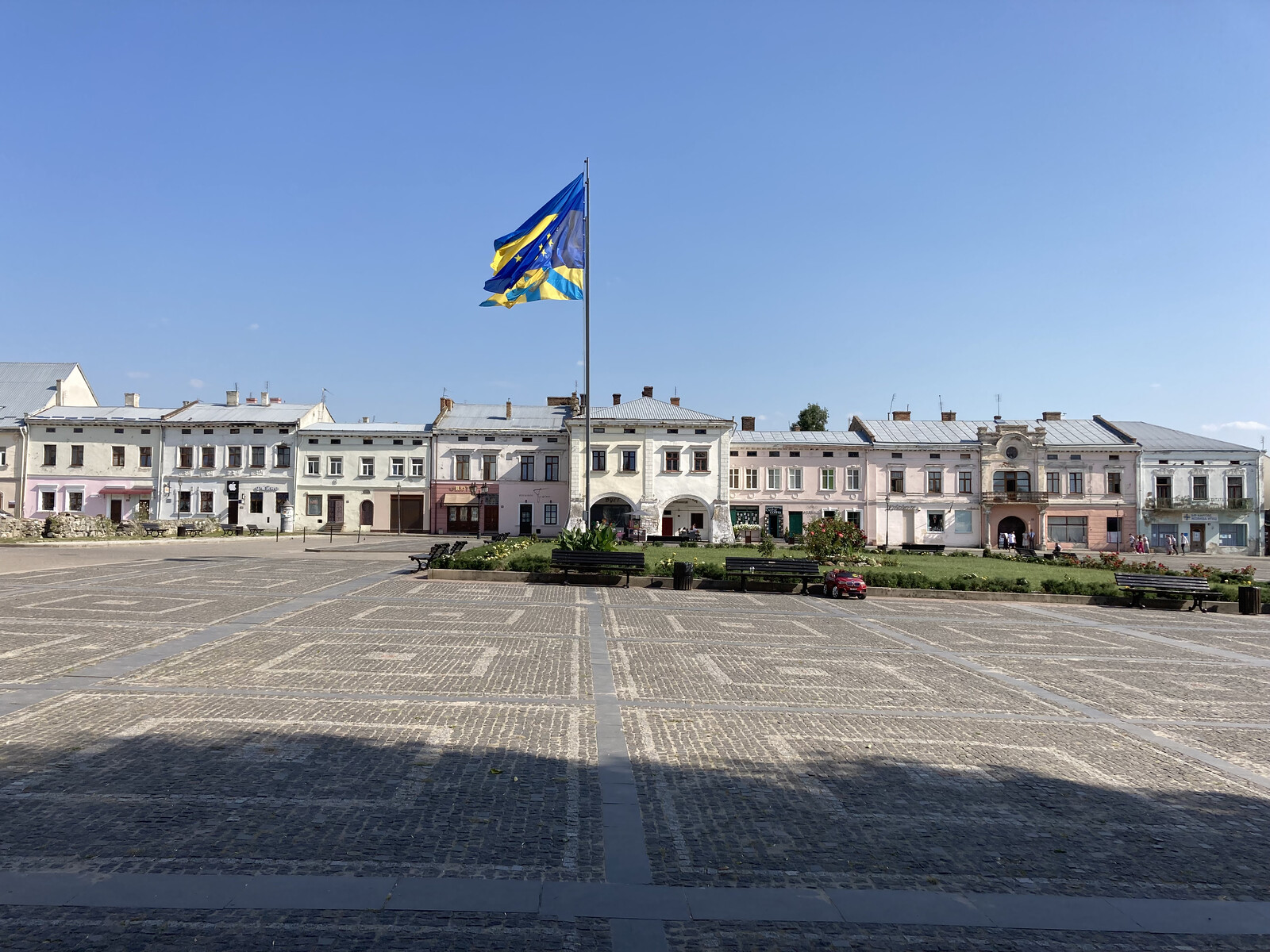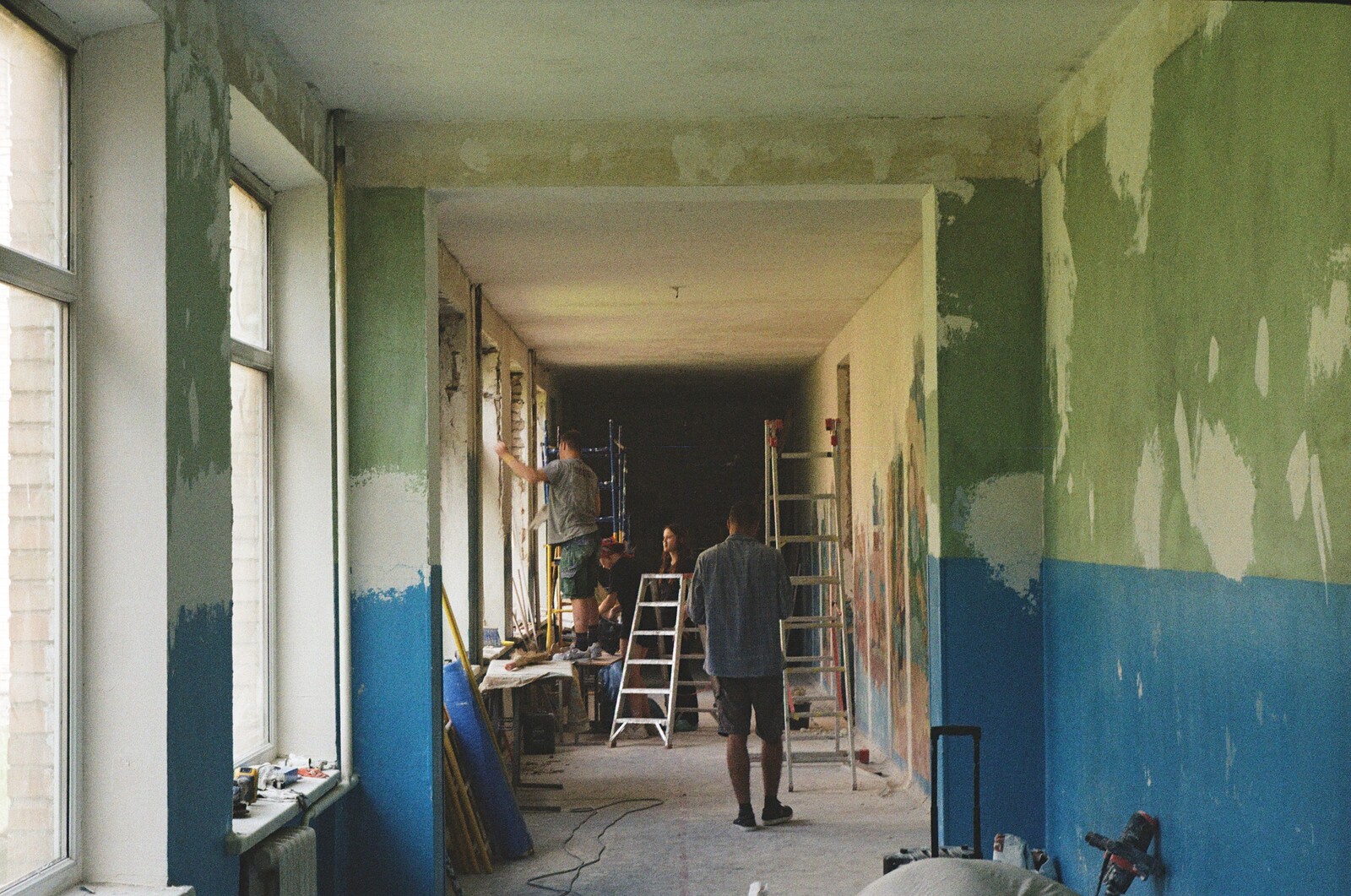CO stands for “collective action”
HATY in Ukrainian means “HOUSES”
COHATY in Ukrainian means “TO LOVE”
The second year of CO-HATY is coming to an end, which means that the anniversary of the dark days of the Russian Army’s full-scale offensive against Ukraine is close at hand. We started CO-HATY by working together as a team plastering walls. Since then, we have expanded our reach to more and more new cities. As we scale up, I often miss opportunities for personal contact with people and physical work. That’s why I’m looking forward to scouting for new sites. We are hitting the road.
Ivano-Frankivsk
Our journey started at home in Ivano-Frankivsk. We were ready at eight in the morning and hopped into the car. There are four of us: myself, my sister Ania, and Mariana and Katia, our METALAB colleagues. We’re on the lookout for new buildings to work on this year. Exploring abandoned buildings has been a passion of mine since childhood, and now we’re all enjoying the process. We envision how, with respect and love for what is existing, we can make welcoming homes for those who have lost everything and are in need of a fresh start.

Hotel before the renovation. Photograph by Anastasiia Kubert.

Hotel after the renovation. Photograph by Oleksandr Demianiv.

Domitory before the renovation. Photograph by Anastasiia Kubert.

Domitory after the renovation. Photograph by Anastasiia Kubert.
Hotel before the renovation. Photograph by Anastasiia Kubert.
During our inspections of potential CO-HATY sites, we conduct a thorough analysis. We start from a macro-level view: what kind of city and neighborhood it is, whether it has all the necessary infrastructure, transport, and green space nearby, etc. Then, we check for connections to external utilities and examine the building’s condition: the roof, foundation, windows. Lastly, we pay attention to the availability of a good air raid shelter either within the house or nearby.
Kitsman
We arrive in Kitsman by 11am. The architecture of the city is stunning, featuring modernist and secessionist styles. The building we were supposed to visit, a former sports school, is located in the center of a beautiful neighborhood, right next to another school. However, as soon as we arrived, an air raid began, and schoolchildren ran past us towards the shelter. As we had many locations to visit that day, we couldn’t afford to wait, so we continued on to our destination.
A man opened the door with an ax. We were laughing and wanted to film it, but he said, “Better not.” The building was previously a sports school, so the rooms were filled with boys’ sneakers.
While exploring the building, we came across peculiar natural “wall paintings” that were both beautiful and eerie. I shared pictures of them on Instagram and asked what they were.
My friend responded that her acquaintance, a mushroom expert, had identified the fungus. It was not harmful to humans, but could cause damage to wooden structures, which meant that we would need to demolish the wall to prevent it from spreading. But the wall was load-bearing and could not be demolished, so we had to abandon the building.
Chernivtsi
Upon arriving in Chernivtsi a few hours later, we were greeted by the head of the Mariupol community in the city. Residents of Mariupol have set up a support network called YaMariupol for their fellow citizens throughout Ukraine. In Chernivtsi, they have rented a building for over a year now, and are seeking funding to renovate it.
I was impressed by the building: the columns already looked very cool. We excitedly explored the different rooms, contemplating what we could plan and how to renovate them. However, the situation with the ground floor would not be easy: there is a lot of humidity and mold, which we will need to address.
At first, our guide seemed calm and distant as she showed us around the building. She had been giving tours to different potential partners for two years, and we were just one of them. She was exhausted. But as we finished the tour, she became emotional and asked if she could hug us. Our visit moved her, and we appreciated that. We saw the beauty in the house, and she felt it, too.
Kamianets-Podilskyi
At around 4pm we headed to Kamianets-Podilskyi, where we were visiting two buildings. Oleksiy, our colleague who works in construction there, joined us. The first building was a school that had been abandoned in the midst of renovations. The walls and floors were covered with grass.
Our grandmother lives in the neighborhood, and our mother had studied at this school as a child. It’s the place of our childhood, where onetime we were walking around the area and came across a group of local boys playing soccer. We struck up a conversation with them and asked about the various buildings in the area. They took us back to the school. It was just getting dark, and we watched the sunset together.
It was already evening, but we decided to quickly inspect the last building, a kindergarten. The large facility had been unoccupied for a long time. Although the location and the structure were attractive, renovating it would take a lot of work and money.
When visiting different sites around Ukraine, I sometimes collect small objects I find and bring them home with me. They remind me of how buildings can change over time, like how abandoned schools can become homes for displaced people during a war. Once people live there, the building takes on a new life, one that is even better than anyone could have imagined when adapting it for its new purpose.
Zinkivtsi
The next morning, before heading home, we stopped at a CO-HATY building in Zinkivtsi, where around 250 people have been residing for a year. The former dormitory building was filled with the scent of food, and children were running through the corridors. We were warmly welcomed and fed. I was happy to see people making their own imprint on the space and settling in.
Creating housing in a socially affordable format is a complex process that impacts the entire space and community. We used to build emergency shelters, but have since realized that people may need homes for a long time, if not forever. All of these people came from frontline regions or war zones. Some people’s homes are gone, so they have nowhere to go back to. With the war intensifying and the future uncertain, we’ve shifted our approach towards establishing a model for non-profit housing that will be managed by the community. We need to train people to work with internally displaced persons, as there are still some administrators who lack the necessary experience to manage dormitories.1 The authorities do not always meet us halfway, and bureaucratic problems often slow down the process. Sometimes, we first have to explain that we are doing good things.
Housing is a fundamental human need, and should not be treated as a tool for investment or speculation. Believing in this, we have recently expanded our efforts and launched three pilot projects for affordable social housing aimed at vulnerable social groups in three regions of Ukraine: Vinnytsia, Khmelnytskyi, and Ivano-Frankivsk. These projects will provide small apartments for families within territorial communities, where local authorities work to integrate IDPs and offer employment opportunities.
We plan to advocate for the social housing model we are developing in collaboration with our partners at Habitat for Humanity in Ukraine at the state level, as there is currently no such model in our country. We aim to increase the funds for affordable housing owned by the state, ensuring that people from various social groups can find peace, comfort, safety, and decent living conditions. Inclusiveness is one of our core values. Therefore, we are also working to improve the accessibility of our projects by preparing some apartments for individuals with disabilities, and taking other steps to ensure everyone’s needs are met.
The issue of housing is critical here and now. Many people are forced to live in uncomfortable conditions for extended periods, lacking privacy and the opportunity to rebuild their lives. Studies in Ukraine show that IDPs return to live under Russian occupation because they cannot see their future and establish roots anywhere else. We are committed to taking action now, leveraging the expertise and experience of our team to support Ukrainian society. Our goal is to provide examples and solutions for other organizations focused on affordable housing in Ukraine while also scaling our values and approaches.
CO-HATY administrators act as mediators between residents and our team. They introduce people to shared living rules, oversee discussions and group activities, and address problems. They also handle repair issues and household organization on site.
Reconstruction is a project by e-flux Architecture drawing from and elaborating on Ukrainian Hardcore: Learning from the Grassroots, the eighth annual Construction festival held in the Dnipro Center for Contemporary Culture on November 10–12, 2023 (2024), and “The Reconstruction of Ukraine: Ruination, Representation, Solidarity,” a symposium held on September 9–11, 2022 organized by Sofia Dyak, Marta Kuzma, and Michał Murawski, which brought together the Center for Urban History, Lviv; Center for Urban Studies, Kyiv; Kyiv National University of Construction and Architecture; Re-Start Ukraine; University College London; Urban Forms Center, Kharkiv; Yale University; and Visual Culture Research Center, Kyiv (2023).

























